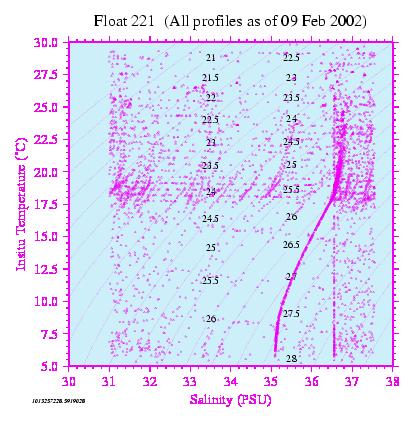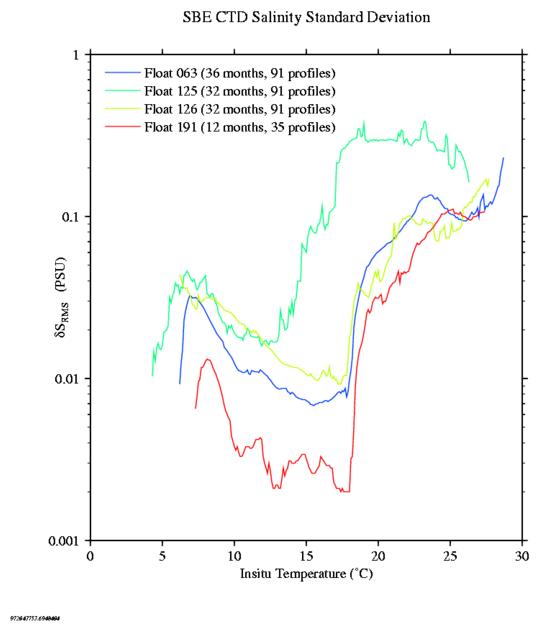
The plot below illustrates the standard deviation in the T-S relation as a function of temperature. Each curve exhibits a band of minimum deviation that locates where the T-S relation has the tightest definition. The typical deviation present within this band gives an upper bound on any potential drift in the salinity measurements. Hence, it is demonstrated that any potential salinity drift in the Sea-Bird CTD is less than approximately 0.01 PSU after two years of operation.

PALACE 063 was the first to be equipped with the Sea-Bird CTD module and was deployed on August 24, 1997. The T-S curves for the first 42 profiles (ie., 14 months) are illustrated in the plot below (red symbols) along with 224 historical profiles (gray symbols) that were collected from the same geographical region. The blue curve represents one standard deviation of the historical data (gray symbols) on either side of the mean and the green curve represents similar statistics for the float data (red symbols). The historical data were real observations included in NOAA's World Ocean Atlas '94 (WOA94). The CTD data were taken exactly as reported by the CTD module - no editing was performed.
Noting the segment in the plot where the T-S relation is particularly well defined, no salinity drift is detectable for PALACE 063 after more than one full year of operation. The salinity standard deviation measured by the float at a temperature of 17° C is 0.009 PSU.
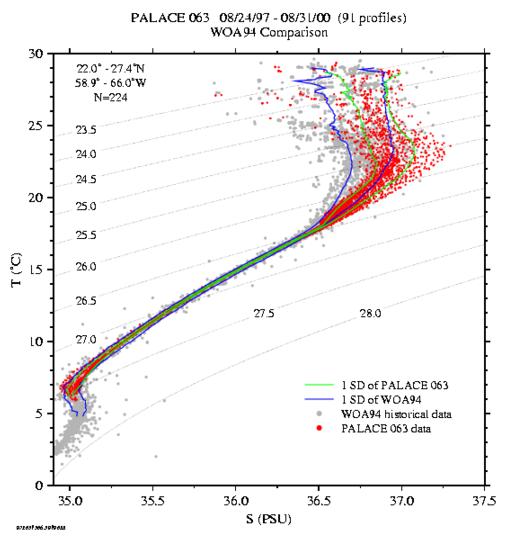
PALACE 125 is equipped with a Sea-Bird CTD module and was deployed on February 14, 1998 via VOS. The first year's (36) profiles of float 125 are included in the T-S plot below (red symbols) along with 278 regional historical profiles(gray symbols) taken from the WOA94. The blue curve represents one standard deviation of the historical data on either side of the mean. In this case, the T-S relation provided by the historical data is too poorly defined to reasonably detect any potential drift by the CTD module. This is explained by the fact that the float crossed the Gulf Stream into coastal and esturine-influenced regions and then crossed back into pelagic waters. Despite the large historical variability, the salinity standard deviation measured by the float at a temperature of 12° C is only 0.0125 PSU.
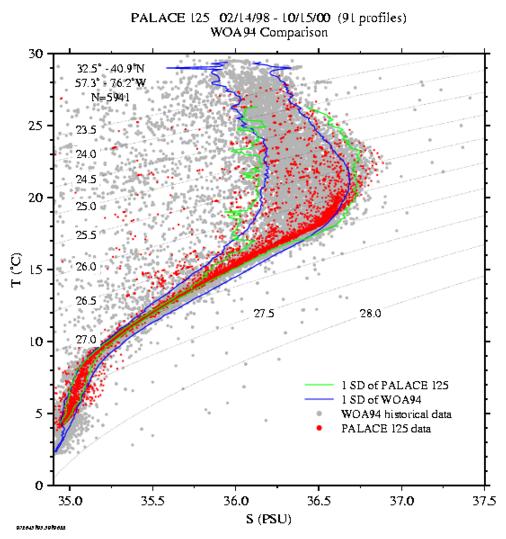
PALACE 126 is equipped with a Sea-Bird CTD module and was deployed on February 14, 1998 via VOS. The first year's (36) profiles of float 126 are included in the T-S plot below (red symbols) along with 537 regional historical profiles(gray symbols) taken from the WOA94. The blue curve represents one standard deviation of the historical data on either side of the mean. Once again no salinity drift is detectable where the T-S relation is particularly well defined. The salinity standard deviation measured by the float at a temperature of 17° C is 0.0037 PSU.
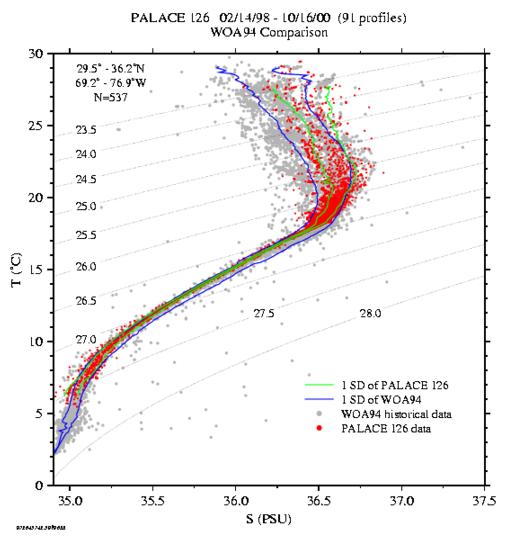
APEX 186 is equipped with a Sea-Bird CTD module and was deployed on September 13, 1998 via VOS. Of the 7 APEX-SBE floats in the trials, this float is the only one to have failed to date. It failed for unknown reasons after completing 18 normal profiles.
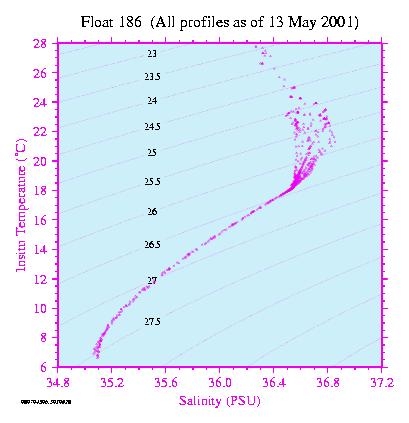
APEX 191 is equipped with a Sea-Bird CTD module and was deployed on September 13, 1998 via VOS. The profiling period is 10.63 days.
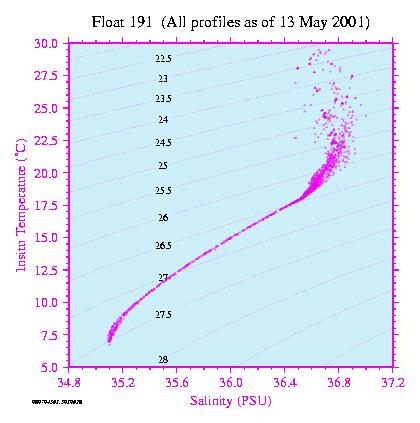
APEX 193 is equipped with a Sea-Bird CTD module and was deployed on January 17, 1999 via VOS. The profiling period is 10.71 days.
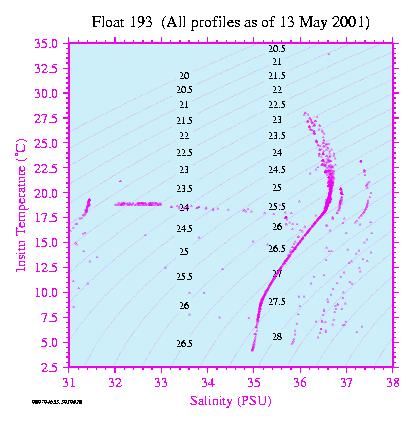
APEX 215 is equipped with a Sea-Bird CTD module and was deployed on February 14, 1999 via VOS. The profiling period is 10.71 days.
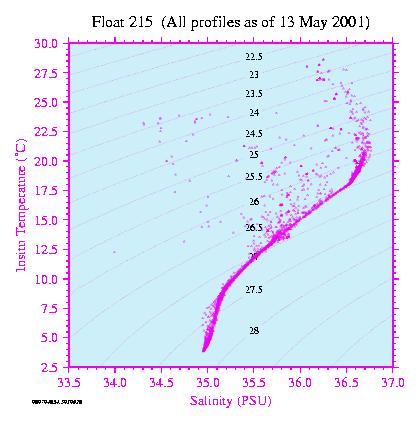
APEX 216 is equipped with a Sea-Bird CTD module and was deployed on February 14, 1999 via VOS. The profiling period is 10.71 days.
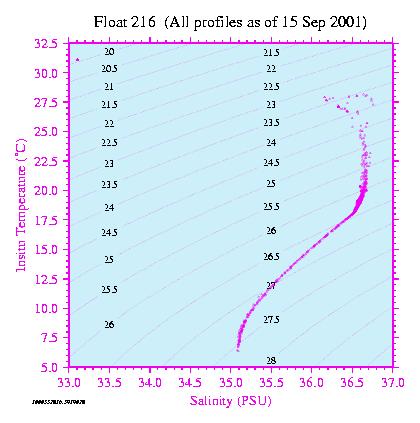
APEX 220 is equipped with a Sea-Bird CTD module and was deployed on February 14, 1999 via VOS. The profiling period is 10.71 days.
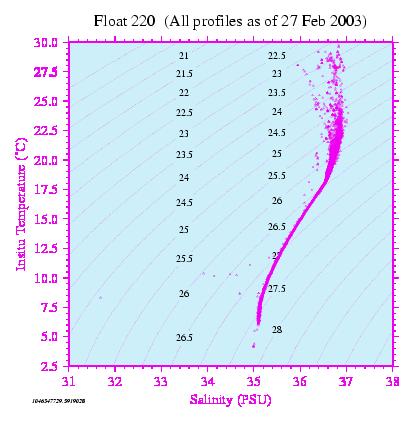
APEX 221 is equipped with a Sea-Bird CTD module and was deployed on February 14, 1999 via VOS. The profiling period is 10.71 days.
